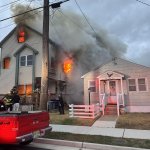COURT HOUSE – A random survey of school districts across Cape May County showed fluctuating enrollments, nearly half of students receiving free or reduced-price meals, and upwards of a third of students labeled as “special education.”
It also showed fluctuations in the number of incidents reported to the state Department of Education (DOE) for violence, vandalism, harassment, intimidation, bullying and substance abuse.
Middle Township Schools, which has pre-K through 12th grades, includes high school students from Middle Township, Avalon, Dennis Township, Stone Harbor and Woodbine.
It has more students this year than last, with 2,512 students enrolled as of Oct. 15.
Lower Cape May Regional, with a high school and a middle school, has its lowest number of students since 2011, at 1,375 this year.
Wildwood, which has elementary, middle and high schools, saw a slight decrease over last year’s enrollment numbers, which were the highest since 2011 at 877. This year, there are 850 students enrolled there.
“There continues to be a trend of fewer students in Cape May County,” said Mark Mallet, Lower Cape May Regional business administrator.
Wildwood Schools Superintendent J. Kenyon Kummings noted, “I think when we saw the economic challenges about 2009, it provided more housing opportunities because of lower prices, so we saw an increase in student enrollment. Wildwood does a nice job with year-round activities, so we saw an increase and have held close to that number since.”
“Tough” Area for Young Families
“The schools are not unlike the county,” noted Patricia Gray Hendricks, who serves as president of the Cape May County Realtors Association. “Without including the transfer patterns of the Coast Guard in Cape May, the criterion for homes throughout the county is not the quality of the schools, but how retirement-friendly the community is.”
Hendricks noted that as a volunteer at Cape May Elementary School and former teacher, she considers the small classroom sizes “intimate, a luxury for teachers really. When I was a teacher, we had 41 students in a classroom. The classrooms in Cape May are much smaller in size, something that parents can really appreciate.”
Many people buy their second home in Cape May County and don’t live in-county year-round, she noted. “It’s hard to find full-time jobs here with benefits,” she continued. “I’ve been to real estate conferences and remember talking with Realtors from places like Austin (Texas) and San Diego (Calif.). They have a tech boom that is driving young people to their communities.
“It’s tough for first-time homeowners here,” Hendricks said. “Sometimes you find a house that has been in a family for a long time and now the younger generation is using it, but still as a seasonal home because of the economic situation.
“You hold on to what you have, but unless you work for the fire department, police department, a municipality or a school, this is a tough area to live in as a young family.”
Hendricks said there are many first-time home buyers in Middle and Lower townships, but often “You will find that once the children have children, the grandparents want to move to be with the grandchildren.
“I think there were fewer jobs this summer as well,” she added.
Hendricks and her husband have had a house in the area for 30 years, the last 10 years as full-time residents. “We’ve seen the advent of wine-making and craft beer creating a buzz and providing some jobs,” she said. “If we can draw younger people here, everyone cherishes the neighborhood school that is smaller and more intimate. We need to figure out how to draw the young people here.”
‘Reflects the Community’
At Middle Township Schools, Diane Fox, business administrator, said their schools reflect the population of Middle Township.
Over the past few years, Middle Township saw a high of 2,657 students in 2012, dropping by 123 students the following year and another 48 the next year, to 2,486 in 2014. This year, enrollment increased by 26 students, to 2,512.
While Fox said the racial makeup of the district is “relatively the same over the past five years,” numbers provided by Fox and the state Department of Education (DOE) indicate some changes: This year, “Currently 20 percent of the students are black, 11 percent Hispanic, 3 percent ‘other ethnic groups’ and 66 percent white,” she said.
DOE reports show that in the 2012-13 school year, 19 percent were black, 8 percent Hispanic, 2 percent Asian, 1 percent ‘two or more’ and 70 percent white. “(This reflects) the population of Middle Township,” she said.
At Lower Cape May Regional, numbers provided by Mallett show the district had a high of 1,538 students in 2011, which dropped to 1,480 in 2012 and then 1,395 in 2013. Last year, there were 1,429 students enrolled in the district compared with 1,375 this year.
Mallett provided the racial makeup of the district’s enrollment as of June: 86 percent white, 8 percent Hispanic, 5 percent black and 1 percent Asian, American Indian or Alaska Native. That barely differs from the 2011-12 school year, as reported on the DOE website, with 86 percent white, 7 percent Hispanic, 5 percent black and the remainder Asian, Native American and Hawaiian.
At Wildwood, which serves pre-K through 12th grade, enrollment stood at 794 in the 2011-12 school year, then 852 in 2012-13, 877 the following year and 850 this year.
About 12 percent of Wildwood students this year are black, 60 percent Hispanic and 25 percent white. The remainder is Asian, Hawaiian and “unclassified,” according to the district.
In the 2011-12 school year 16 percent of Wildwood students were black, 53 percent Hispanic and 31 percent white. At that time, there also was a student classified with Hawaiian background and another with “two or more” racial backgrounds.
‘Choice’ District
This is the third year that students from Woodbine can elect to attend Middle Township High School (grades 9, 10, 11) as part of a send-receive relationship established to help decrease travel time for students. “Students from Woodbine were going to Millville schools, crossing county lines and sometimes traveling 45 minutes,” explained Fox.
“This became a problem especially for after-school activities,” she said. “A study was done to determine the feasibility of transporting the students to Middle Township and we applied to the state for approval for up to 115 Choice seats. The state granted us 29 slots and we filled 17 of them, so that is what we are now limited to.”
New Jersey’s Interdistrict Public School Choice Program enables approved choice districts to enroll K-12th grade students who do not reside within their districts without cost to their parents.
According to the state DOE website, the program “increases educational opportunities for students and their families by providing students with school options outside of their district of residence and giving parents the power to select a school program that best serves their child’s individual needs.”
District participation in the program is optional. Once approved, the choice district designates the available seats in specific grades and programs that are open to choice students.
Where choice options are available, any student who resides in New Jersey is eligible to apply.
There are currently 131 participating Choice Districts for the 2015-16 school year.
Parents were able to apply for a Choice seat in grades 6-12 at Middle Township by Dec. 1. “If a seat is available, then they can attend our schools. If there are more requests than seats, there is a waiting list and we will do a lottery to select the students who can attend,” Fox noted.
The state also has many small districts and schools that sometimes experience population shifts that result in budget crunches, according to the DOE website. “Opening enrollment beyond the district’s boundaries can alleviate the effects of these shifts and bring greater stability to operations, since choice students bring additional funding to the district. The addition of students with different backgrounds and perspectives from those of the district’s resident students also can enrich the school community.”
Any school district sending students to Middle Township High School pays $11,200 tuition per student. “This is based on a formal send-receive relationship established through the DOE,” Fox said.
“Low Income” Adds Funds
Those receiving reduced-cost or free meals are considered “low income” by state definitions. The U.S. Department of Agriculture Food and Nutrition Service website describes income eligibility for free meals as those at or below 130 percent of the poverty level, or for a family of four, an income of $31,525 a year. To obtain reduced-price meals, a family of four would earn no more than $44,863 a year, which is 185 percent of the poverty level.
In Middle Township 45 percent of students are considered low income this year compared to 41 percent last year.
At Lower Cape May Regional, 45 percent of students this year are considered low income compared to 48 percent last year. Mallett indicated these numbers include “out-of-district students” as well.
In Wildwood schools, about 90 percent of the elementary school students are considered low income, almost 87 percent in the middle school and about 74 percent at the high school.
“We receive students from North Wildwood and Wildwood Crest at the high school level,” Kummings said, “so it diversifies our student body a little more.”
Because more than 40 percent of the students are considered low income, the districts are eligible for additional federal funding under programs such as No Child Left Behind (NCLB), which encompasses Title I, Title IIA and Title III programs.
These programs are geared to providing financial assistance to local educational agencies and public schools with high numbers or percentages of poor children to help ensure that all children meet challenging state academic content and student academic achievement standards.
At Middle Township, Fox said the NCLB funds are used to provide summer school, after-school programs and in-school support.
Lower Cape May Regional uses its Title I funds to supplement student needs in language arts and mathematics.
“Our teachers have done a good job in understanding the students and the challenges that are presented, so we know what services and resources we have to provide,” Kummings added about the Wildwood schools.
He indicated this also included a “comprehensive process” conducted by the Child Study Team to identify special needs. He said about 32 percent of high school students, a third of the middle school and 15 percent of elementary students are considered “special ed,” thus requiring Individual Education Plans (IEPs) to address learning challenges.
Under state law, students between the ages of 3 and 21 are eligible for special education and related services if they meet the criteria for one or more of 14 recognized disabilities.
Eligibility is determined collaboratively by the IEP team, which can recommend classification only if the student’s academic deficiencies are not the result of a “lack of instruction in reading, including the essential components of reading instruction, or math or due to limited English proficiency.”
“Many of our challenges are due to limited English-speaking abilities,” Kummings said about Wildwood schools, noting in most cases the students speak Spanish as their primary language, although, “occasionally there will be a student from Russia and I recall we had one from Thailand.”
This requires English as Second Language (ESL) classes across the board, although the need is higher in the Wildwood elementary school where 35 percent require ESL, 8.9 percent in middle school and 3.6 percent in high school.
“The state wants a student out of the program within three years, but we know it takes seven years for a student to be really proficient in a language, which means having speaking, writing and understanding skills,” he explained. “What you see is that as the students become more proficient in the language, they do better in things like standardized testing.
“We are lucky that we really have to focus on one language usually,” he added. “In Atlantic City, for example, they have more than 40 languages. Our ESL teachers teach English by speaking it in the classroom, and we’ve got a good group of teachers who have become ESL-certified so it’s been helpful.”
At Middle Township, Fox said about 22 percent of the students are considered “special education,” requiring IEPs to address learning deficiencies.
In addition, “We do have English as ESL students and the language is mainly Spanish, but we do have several Asian languages as well,” Fox said. “The Asian population is about 2 percent.”
Lower Cape May Regional has remained relatively steady with 28 percent of its students classified as special education over the past several years. Mallet said the majority of these students are mainstreamed within classes.
Student Behavior Reports
The school districts are also required to report to the state DOE on student behavior, including reports on the “broad” categories of violence and vandalism, harassment, intimidation and bullying (HIB), and substance abuse incidents. Those numbers vary from year to year, and school officials were reluctant to provide any insight into why.
Reports filed with the state DOE show that Lower Cape May Regional schools reported 32 incidents of violence and vandalism in the 2011-12 school year, decreasing to 23 last year. HIB incidents declined from 11 to 5 over the same period, however, substance abuse incidents increased from 21 to 36. Mallett did not offer any explanation about what caused the increase in substance abuse incidents or what kinds of incidents they were, other than to say, “These statistics vary from year to year.”
Reports of an increase in behavioral problems at the Middle Township High School are unfounded, according to Fox. “I don’t think we are having any more problems than we have had in the past,” she said, “and the discipline problems are not caused by students from any particular district.”
Reports filed with the state DOE, however, show that Middle Township schools reported 22 violence and vandalism incidents in the 2011-12 school year and 28 in the 2014-15 school year.
HIB incidents decreased from 18 to 10 over the same period. Substance abuse incidents increased, however, from 13 to 28 over the same period, according to the state’s DOE website, which states the incidents are self-reported and verified by the school districts.
When asked about these numbers and the possible reasons behind their increase or decrease and what types of incidents they might be, Fox said, “The numbers vary from year to year and I cannot comment on the (violence and vandalism) incidents as they involve students. Decrease in HIB is due to the many programs and education we have provided to staff and students. As for substance abuse, look at the county averages. I cannot discuss specific incidents.”
Because of the “transient” nature of the students, Kummings said Wildwood students “share similar challenges. One of the neat things about our students at the high school, for instance, is that their feedback indicates they are embraced by students and teachers alike, even those who come to our school mid-year.
“There is an empathy that they share because they share the same challenges” he noted.
“The state has its own definition for bullying which means it has to be directly related to a characteristic that can’t be changed, such as race, gender, sexual orientation. The state wants to know those acts motivated by discrimination; they want to provide students with the same protection as adults,” Kummings explained.
State DOE reports show Wildwood city schools reported a decrease from 26 to nine violence and vandalism incidents over the past five years. HIB incidents doubled from four to eight, and substance abuse incidents remained steady at six over the same period.
According to the DOE, the violence and vandalism report, which is presented annually to the governor and Legislature, “Transparently communicates the changes in self-reported incidents from year to year. However, the report does not analyze the reasons for the changes. Changes from one year to the next may be attributed to more accurate reporting from districts or may reflect the results of local school policies and programs to address violence, vandalism, substance abuse and bullying.”
To contact Karen Knight, email kknight@cmcherald.com.
DOE reports can be found at http://www.state.nj.us/education/data/.
Del Haven – Timothy Snyder, award winning historian, author, and professor, explains that destroying a country requires undermining five key zones: "health, law, administration, defense, and intelligence….








